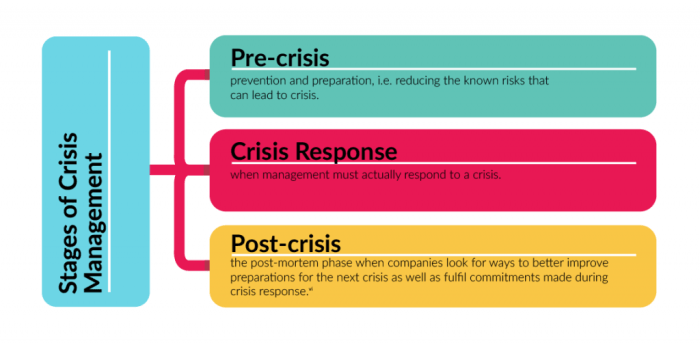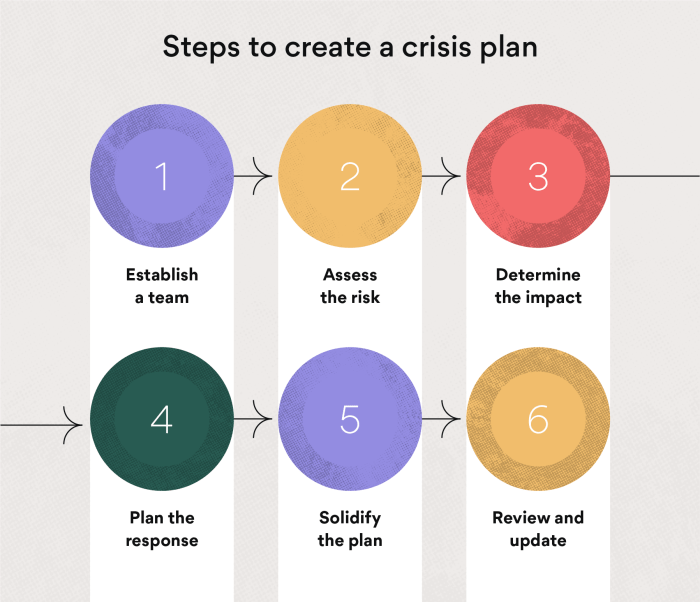Developing a Crisis Management Plan: Key Strategies for Effective Preparedness kicks off this wild ride into the world of handling crises like a boss. Get ready for some serious insight and tips on navigating through turbulent times with style and grace.
In this guide, we’ll dive deep into the crucial aspects of crisis management, from understanding its importance to developing a rock-solid plan that can save the day when chaos strikes.
Understanding Crisis Management

Crisis management is the process by which an organization prepares for and responds to unexpected events that could potentially harm the organization, its stakeholders, or the general public. It is crucial for organizations to have a well-thought-out crisis management plan in place to effectively handle crises when they arise.
Key Elements of a Crisis Management Plan
- Establishing clear roles and responsibilities for key personnel
- Creating a communication plan to keep stakeholders informed
- Identifying potential risks and preparing response strategies
- Regularly testing and updating the crisis management plan
Consequences of Not Having a Crisis Management Plan
Without a crisis management plan, organizations are at risk of being unprepared to handle unexpected events, leading to confusion, chaos, and potential damage to their reputation and operations. In extreme cases, not having a crisis management plan could result in financial losses, legal issues, or even closure of the organization.
Real-Life Examples of Effective Crisis Management
- Johnson & Johnson’s handling of the Tylenol poisoning crisis in 1982, where they quickly recalled products and implemented new safety measures to protect consumers.
- The response of Starbucks to an incident in one of their stores in Philadelphia, where they issued a public apology and announced training for staff on diversity and inclusion.
- The crisis management efforts of Airbnb during the COVID-19 pandemic, offering refunds and support to hosts and guests affected by travel restrictions.
Developing a Crisis Management Team
Creating a crisis management team is crucial for effectively handling unexpected situations. Each member plays a vital role in ensuring a coordinated and efficient response to crises.
The Roles and Responsibilities of Individuals within a Crisis Management Team
- Team Leader: Responsible for overall coordination and decision-making during a crisis.
- Communications Coordinator: Manages internal and external communications to ensure accurate information is shared.
- Subject Matter Experts: Provide specialized knowledge and guidance related to specific aspects of the crisis.
- Operations Manager: Oversees the implementation of response plans and allocation of resources.
- Legal Advisor: Offers legal guidance to ensure actions taken during a crisis are compliant with regulations.
The Importance of Cross-Departmental Representation in a Crisis Management Team
Having representatives from different departments ensures diverse perspectives and expertise are available when making decisions. It allows for a more comprehensive understanding of the crisis and facilitates a holistic response.
How to Select Team Members Based on Their Skills and Expertise
- Evaluate individuals based on their relevant experience, problem-solving skills, and ability to remain calm under pressure.
- Consider diversity in skills and backgrounds to cover a wide range of scenarios.
- Ensure each team member understands their role and responsibilities clearly.
Share Tips for Training and Preparing a Crisis Management Team for Various Scenarios
- Conduct regular training exercises to simulate different crisis situations and test response plans.
- Provide ongoing education on crisis management best practices and updates on potential risks.
- Encourage open communication and collaboration among team members to enhance coordination during a crisis.
Risk Assessment and Scenario Planning: Developing A Crisis Management Plan

Risk assessment is a crucial step in crisis management, as it helps organizations identify potential threats and vulnerabilities that could lead to crises. By conducting risk assessments, organizations can proactively plan and prepare for various scenarios that may arise.
Conducting Risk Assessments
- Identify and prioritize potential risks based on likelihood and impact.
- Assess current control measures in place to mitigate risks.
- Engage stakeholders from different levels of the organization to gather diverse perspectives.
Scenario Planning for Crisis Preparedness
- Create hypothetical scenarios based on identified risks to simulate crisis situations.
- Develop response strategies for each scenario to enhance preparedness.
- Conduct tabletop exercises to test the effectiveness of the response strategies.
Tools and Methodologies
- SWOT analysis: Evaluates strengths, weaknesses, opportunities, and threats to assess risks.
- PESTLE analysis: Considers political, economic, social, technological, legal, and environmental factors impacting risks.
- Failure Mode and Effects Analysis (FMEA): Identifies potential failures and their consequences in a systematic manner.
Regular Reviews and Updates, Developing a Crisis Management Plan
- Periodically review and reassess identified risks to adapt to changing circumstances.
- Update response strategies based on lessons learned from past crises and emerging threats.
- Engage in continuous improvement to enhance the effectiveness of risk assessment and scenario planning.
Communication Strategies in Crisis Management
Effective crisis communication is essential in managing a crisis situation. It involves having a well-thought-out plan in place to ensure that information is disseminated accurately and efficiently. Transparency and timeliness are key components of a successful crisis communication plan. Tailoring communication strategies for different stakeholders and maintaining open channels of communication are crucial aspects that must be considered.
Key Components of an Effective Crisis Communication Plan
- Establishing a designated spokesperson or team to handle communications
- Creating pre-approved templates for different types of crisis situations
- Utilizing multiple communication channels such as social media, press releases, and direct emails
- Monitoring and responding to feedback and questions from stakeholders
Importance of Transparency and Timeliness
-
Transparency
helps build trust and credibility with stakeholders
-
Timeliness
ensures that information is shared promptly to prevent misinformation or speculation
Tailoring Communication Strategies for Different Stakeholders
- Identify the specific needs and concerns of each stakeholder group
- Use language and tone appropriate for each audience
- Provide relevant information that is specific to the stakeholder’s role or relationship to the organization
Best Practices for Maintaining Communication Channels
- Regularly update stakeholders on the progress of the crisis situation
- Be available to answer questions and address concerns in a timely manner
- Ensure consistency in messaging across all communication channels
- Prepare for potential communication challenges and have contingency plans in place
